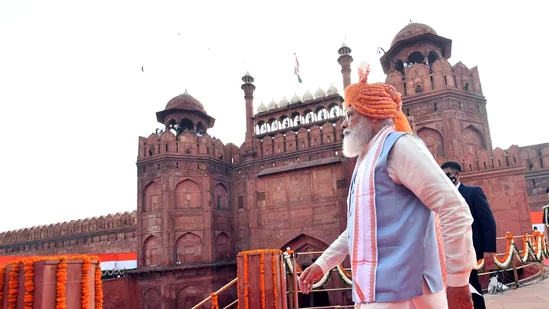In a speech that began with an acknowledgment of the contribution of India’s freedom fighters including Jawaharlal Nehru, outlined recent steps India had taken to ensure the “ease of living” and “ease of doing business”, highlighted current governance challenges including the pandemic and the climate crisis, and laid out a future vision for India at 100 in 2047, Prime Minister Narendra Modi said that no obstacle could stop the country from achieving its dreams in the 21st century and declared that India now has the political will to undertake major reforms. Importantly, he said everyone has to do their bit to achieve all this, adding “sabka prayas” (everyone’s effort) to his government’s slogan.
Addressing the nation from the ramparts of the Red Fort on India’s 75th Independence Day, PM Modi unveiled a national blueprint with limited State interference in the everyday life of citizens; a focus on small farmers and rural economy; energy independence with the announcement of a National Hydrogen Mission; a boost to manufacturing, technology, infrastructure and start-ups; employment generation for the young with a ₹100 lakh crore PM Gati Shakti master plan; equity for women and vulnerable sections of society; and balanced regional development with a focus on Jammu and Kashmir, Ladakh and the Northeast.
In a reference to national security challenges from Pakistan and China, without naming the two countries, the PM underlined India’s battle against “terrorism” and “expansionism” and said the country would do all it needed to strengthen the armed forces. He did not, however, mention the evolving situation in Afghanistan, where the Taliban reached the gates of Kabul on Sunday, after a successful military offensive across the country.
India’s Olympic contingent was present at the Red Fort, with PM Modi hailing the success of Indian athletes — with seven medals across six sports, India had its most successful run in Tokyo this year.
The Opposition has criticised the speech, with the Congress accusing him of only making announcements about schemes in his Independence Day speeches and not implementing them. “He announces new schemes but these are never implemented or seen on the ground. He says a lot of things but never adheres to them,” senior Congress leader Mallikarjun Kharge told reporters.
The Congress also took a swipe at the PM for his announcement of ₹100 lakh crore for the infrastructure sector, saying he has been talking of it since 2019. “It has been two years since August 15, 2019. At least, the 100 lakh crore figure could have been changed,” Congress chief spokesperson Randeep Surjewala said in a tweet.
In his speech, the PM focused on the past, present and the future.
Looking back, he hailed the contribution of a range of freedom fighters from across different strands (both non-violent and revolutionary) of the national movement, spoke of India’s struggle for the “motherland, culture and freedom”, and reiterated that August 14 would be henceforth marked as the Partition Horrors Remembrance Day. “It was one of the biggest tragedies of the last century and the memories of the pain persist… people went through inhuman times… and many didn’t even get a proper farewell. It is important for them to be alive in our memories.” The government’s announcement to this effect on Saturday triggered a mixed response, with many hailing it as a much-needed effort at acknowledging the past while others criticising it for reopening old wounds which may aggravate the politics of division.
Turning to the present, the PM spoke of the Covid-19 pandemic as a huge challenge, hailed Corona warriors for their contribution, and highlighted India’s vaccination programme, the world’s largest such exercise. “India doesn’t need to be dependent on others for vaccines. Imagine what would have happened if India didn’t have its own vaccine? Where would we have got it?” While both Covishield and Covaxin are manufactured in India (the latter has also been developed in India), the government has come under criticism for not ensuring timely clearance to foreign-made vaccines which would have helped meet the supply deficit.
But the PM also acknowledged the scale of the devastation without directly referring to the second wave this summer, which saw daily cases climb up to over 400,000 and deaths cross 4,000 — widely seen by experts as a conservative estimate. “It is true that fewer people in India have got infected, that we have succeeded in saving more people in terms of population ratio compared to other countries. But to say that we didn’t face challenges would be to close doors for development in the future. We have fewer resources, our population is higher, our lifestyle is different. Despite all our efforts, we couldn’t save many people and this intolerable pain will stay with us.”
A large part of the PM’s speech was focused on welfare delivery, justice for vulnerable segments and steps undertaken for rural economy and farmers.
While outlining the various welfare measures in the past seven years — for instance, provision of gas cylinders through the Ujjwala scheme, rural roads and housing, toilets, electrification, health insurance through Ayushman Bharat, and financial inclusion — the PM said it was now time to move towards saturation coverage. “The pace of government schemes has increased, they are meeting their targets, the poor are benefiting directly now. But we now need to move towards 100% coverage.”
The PM made it clear — at a time when the debate on reservations, caste census, and categorisation of Other Backward Classes (OBCs) has made its way back in political discourse — that there had to be “handholding” of the marginalised. Beyond facilities, this meant continued reservations for Dalits, tribals, OBCs and poor of general categories.
He also spoke of the need for development to be all-inclusive and all-encompassing, touching all regions. “India’s east, Northeast, Jammu and Kashmir, Ladakh, Himalayan region states, coastal areas, the tribal belt will become the basis of India’s development in the future.” The PM said there has been balanced regional development in both Jammu and Kashmir after the effective abrogation of Article 370 and referred to the establishment of the delimitation commission and plans to hold assembly elections; spoke of Ladakh’s development potential; highlighted the enhanced connectivity in the Northeast and between the Northeast and India’s neighbours to the east; and focused on improved development indicators in 110 aspirational districts.
In terms of the rural economy, the PM spoke of enhanced facilities and connectivity in villages giving rise to digital entrepreneurs, the value of cooperatives in the backdrop of the formation of a separate ministry of cooperation at the Centre (led by Amit Shah), and the role of self-help groups, announcing a new e-commerce platform to enable such groups to market and sell their products elsewhere.
But the PM’s focus was on agriculture — in the context of prolonged opposition to the new farm laws pushed by the Centre last year. The PM spoke of the need to incorporate scientific feedback to enhance production, and why India must frame policies keeping in view the interests of small farmers, even coining a new slogan of how small farmers are the “pride of India”. “80% of India’s farmers own less than 2 hectares of land each; there is increased fragmentation of land. Past policies did not prioritise these farmers. Agricultural reforms are meant to benefit these farmers”. The PM highlighted the government’s insurance scheme, Kisan credit card, farmers producers organisation, construction of warehouses at the block level, the PM-Kisan scheme under which farmers get an income assistance of ₹6000 each annually, Kisan rail links, and steps to boost export potential of agriculture as evidence of a shift in policy.
But along with this, with an eye on the future, the PM also flagged the role of sectors which are essential for India’s future development trajectory — “next generation infrastructure… world class manufacturing… cutting edge technology… new age technology”.
In this context, he referred to Make in India (singling out electronics manufacturing and indigenous defence production as successes), the role of infrastructure (with a focus on the ₹100 lakh crore national infrastructure pipeline), the success of startups (with a reference to how they are the new “wealth creators”, with many have turned into unicorns of a valuation in excess of $1 billion), and exports (with an appeal to Indian exporters to focus on quality with an eye on global markets). “Major reforms and decisions need political will. And in India, there is no shortage of political will. The world knows we are writing a new chapter of governance”.
Redefining the idea of next generation reforms, the PM focused on the need to make service delivery more accessible for citizens till the last mile. “Earlier, the government was in the driving seat. Now, times have changed. We must end the unnecessary interference of the government and government processes in the lives of citizens. We have liberated people from unnecessary laws… 15,000 compliance requirements were ended… Liberation from laws is good for both ease of living and ease of doing businesses.”
The PM also spoke of the role of education, in light of the New Education Policy, with a focus on how education in one’s mother tongue is a weapon in the fight against poverty and need not be an obstacle. Taking off from the success of women athletes in the Tokyo Olympics, the PM highlighted how women were excelling in each field and ready to take their space and it was the duty of citizens, police, the criminal justice system and all stakeholders to ensure women were secure and had respect. He also announced that Sainik schools will now be open for girls too.
With climate emerging as a key governance challenge — with new warnings about how the climate crisis is already straining environment and will have huge implications for India’s political economy and livelihoods — the PM said environmental security was now a part of national security.
He said that India was an energy dependent nation, spending ₹12 lakh crore for its energy needs every year — and declared a goal of making India energy independent by the 100th year of Indian independence. The PM also announced the launch of a National Hydrogen Mission, a mission circular economy, and highlighted attempts in areas of recycling, organic farming, energy conservation, protection of wildlife and increase of forest cover, renewables.
“India is changing… it can take difficult decisions and doesn’t hesitate,” said PM Modi, referring to the decisions on Article 370, the rollout of the Goods and Services Tax, implementation of one-rank-one-pension, peaceful resolution of the Ram Janmabhoomi dispute, constitutional status to the backwards commission, district elections in Kashmir, record foreign direct investment , and surgical and air strikes across the border.






